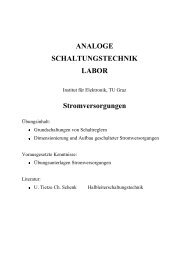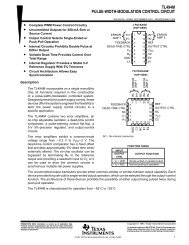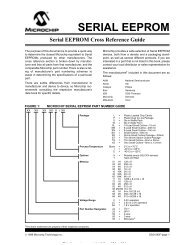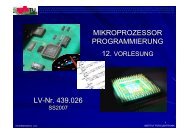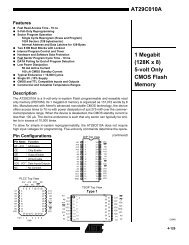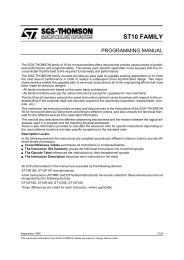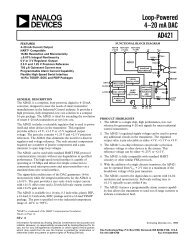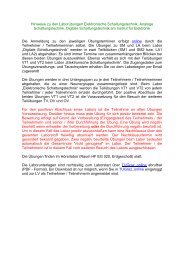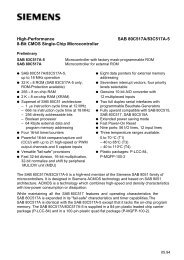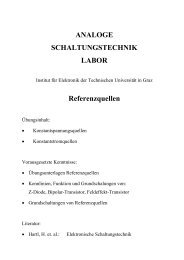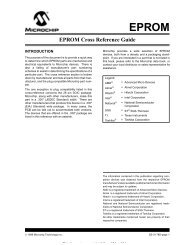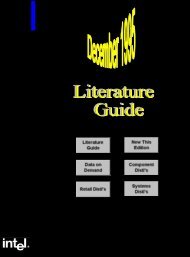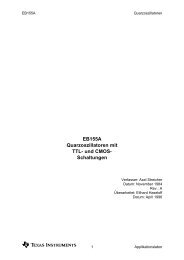AN61-1 Application Note 61 August 1994 Practical Circuitry for ...
AN61-1 Application Note 61 August 1994 Practical Circuitry for ...
AN61-1 Application Note 61 August 1994 Practical Circuitry for ...
Create successful ePaper yourself
Turn your PDF publications into a flip-book with our unique Google optimized e-Paper software.
<strong>Application</strong> <strong>Note</strong> <strong>61</strong>Wideband, Thermally-Based RMS/DC Converter<strong>Application</strong>s such as wideband RMS voltmeters, RF levelingloops, wideband AGC, high crest factor measurements,SCR power monitoring and high frequency noisemeasurements require wideband, true RMS/DC conversion.The thermal conversion method achieves vastlyhigher bandwidth than any other approach. ThermalRMS/DC converters are direct acting, thermoelectronicanalog computers. The thermal technique is explicit, relyingon “first principles,” e.g,. a wave<strong>for</strong>ms RMS value isdefined as its heating value in a load.Figure 22 is a wideband, thermally-based RMS/DC converter.3 It provides a true RMS/DC conversion from DC to10MHz with less than 1% error, regardless of input signalwaveshape. It also features high input impedance andoverload protection.The circuit consists of three blocks; a wideband FET inputamplifier, the RMS/DC converter and overload protection.The amplifier provides high input impedance, gain anddrives the RMS/DC converters input heater. Input resistanceis defined by the 1M resistor with input capacitanceabout 3pF. Q1 and Q2 constitute a simple, high speed FETinput buffer. Q1 functions as a source follower, with the Q2current source load setting the drain-source channel current.The LT1206 provides a flat 10MHz bandwidth gain often. Normally, this open-loop configuration would be quitedrifty because there is no DC feedback. The LT1097contributes this function to stabilize the circuit. It does thisby comparing the filtered circuit output to a similarlyfiltered version of the input signal. The amplified differencebetween these signals is used to set Q2’s bias, andhence Q1’s channel current. This <strong>for</strong>ces Q1’s V GS towhatever voltage is required to match the circuit’s inputand output potentials. The capacitor at A1 provides stableloop compensation. The RC network in A1’s output preventsit from seeing high speed edges coupled throughQ2’s collector-base junction. Q4, Q5 and Q6 <strong>for</strong>m a lowleakage clamp which precludes A1 loop latch-up duringstart-up or overdrive conditions. This can occur if Q1 ever<strong>for</strong>ward biases. The 5K-50pF network gives A2 a slightpeaking characteristic at the highest frequencies, allowing1% flatness to 10MHz. A2’s output drives the RMS/DCconverter.The LT1088 based RMS/DC converter is made up ofmatched pairs of heaters and diodes and a control amplifier.The LT1206 drives R1, producing heat which lowersD1’s voltage. Differentially connected A3 responds bydriving R2, via Q3, to heat D2, closing a loop around theamplifier. Because the diodes and heater resistors arematched, A3’s DC output is related to the RMS value of theinput, regardless of input frequency or waveshape. Inpractice, residual LT1088 mismatches necessitate a gaintrim, which is implemented at A4. A4’s output is the circuitoutput. The LT1004 and associated components frequencycompensate the loop and provide good settlingtime over wide ranges of operating conditions (see Footnote3).Start-up or input overdrive can cause A2 to deliver excessivecurrent to the LT1088 with resultant damage. C1 andC2 prevent this. Overdrive <strong>for</strong>ces D1’s voltage to anabnormally low potential. C1 triggers low under theseconditions, pulling C2’s input low. This causes C2’s outputto go high, putting A2 into shutdown and terminating theoverload. After a time determined by the RC at C2’s input,A2 will be enabled. If the overload condition still exists theloop will almost immediately shut A2 down again. Thisoscillatory action will continue, protecting the LT1088until the overload condition is removed.<strong>Note</strong> 3: Thermally based RMS/DC conversion is detailed in Reference 9.<strong>AN<strong>61</strong></strong>-16



